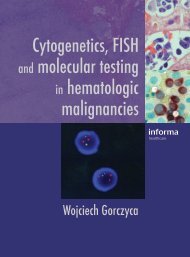Color Atlas of Hematology - Practical Microscopic and Clinical ...
Color Atlas of Hematology - Practical Microscopic and Clinical ...
Color Atlas of Hematology - Practical Microscopic and Clinical ...
- No tags were found...
Create successful ePaper yourself
Turn your PDF publications into a flip-book with our unique Google optimized e-Paper software.
66Abnormalities <strong>of</strong> the White Cell SeriesReactive LymphocytosisLymphatic cells show wide variability <strong>and</strong> transform easily. This is usuallyseen as enlarged nuclei, a moderately loose, coarse chromatin structure,<strong>and</strong> a marked widening <strong>of</strong> the basophilic cytoplasmic layer.<strong>Clinical</strong> findings, which include acute fever symptoms, enlarged lymphnodes, <strong>and</strong> sometimes exanthema, help to identify a lymphatic reactivestate. Unlike the case in acute leukemias, erythrocyte <strong>and</strong> thrombocytecounts are not significantly reduced. Although the granulocyte count isrelatively reduced, its absolute value (per microliter) rarely falls below thelower limit <strong>of</strong> normal values.Morphologically normal lymphocytes predominate in the blood analyses inthe following diseases:➤ Whooping cough (pertussis) with clear leukocytosis <strong>and</strong> total lymphocytecounts up to 20 000 <strong>and</strong> even 50 000/µl; occasionally, slightlyplasmacytoid differentiation.➤ Infectious lymphocytosis, a pediatric infectious disease with fever <strong>of</strong>short duration. Lymphocyte counts may increase to 50 000/µl.➤ Chickenpox, measles, <strong>and</strong> brucellosis, in which a less well-developedrelative lymphocytosis is found, <strong>and</strong> the counts remain within the normalrange.➤ Hyperthyroidism <strong>and</strong> Addison disease, which show relative lymphocytosis.➤ Constitutional relative lymphocytosis, which can reach up to 60% <strong>and</strong>occurs without apparent reason (mostly in asthenic teenagers).➤ Absolute granulocytopenias with relative lymphocytosis (p. 86).➤ Chronic lymphocytic leukemia (CLL), which is always accompanied byabsolute <strong>and</strong> relative lymphocytosis, usually with high cell counts.Transformed, “stimulated” lymphocytes (“virocytes”) predominate in theCBC in the following diseases with reactive symptoms:➤ Lymphomatous toxoplasmosis does not usually involve significantleukocytosis. Slightly plasmacytoid cell forms are found.➤ In rubella infections the total leukocyte count is normal or low, <strong>and</strong> thelymphocytosis is only relatively developed. The cell morphology rangesfrom basophilic plasmacytoid cells to typical plasma cells.➤ In hepatitis the total leukocyte <strong>and</strong> lymphocyte counts are normal.However, the lymphocytes <strong>of</strong>ten clearly show plasmacytoid transformation.➤ The most extreme lymphocyte transformation is observed in mononucleosis(Epstein–Barr virus [EBV] or cytomegalovirus [CMV] infection)(p. 68).






